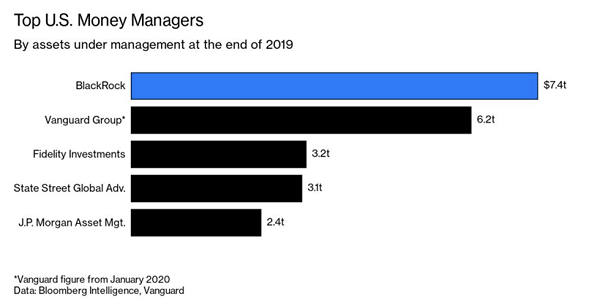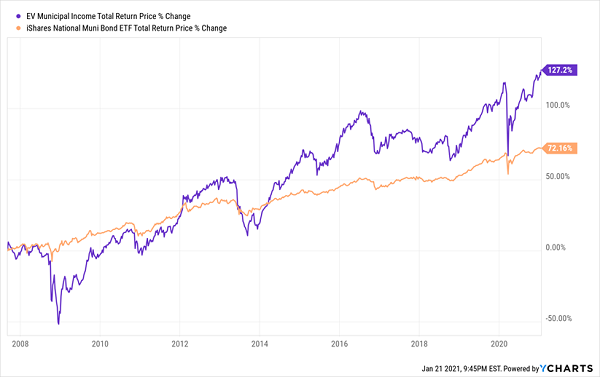Don’t listen to the index-fund crowd: it is possible to beat the market year in and year out—and you can do it while grabbing big 7%+ dividends, too!
There are three steps to pulling off this feat:
- Go with a high-yield closed-end fund (CEF): many of these funds return more than their benchmarks on the regular! AND because they pay 7% dividends, on average, you get a large portion of your gain in cash!
- Look beyond stocks: Other markets, like corporate bonds and municipal bonds, are far less “democratic” than the stock market: in other words, the big players get the pick of the crop! And we can use this to our advantage when we …
- Go with a fund from a well-established CEF issuer. That’s because these investment houses attract top Wall Street talent. They also boast another unique “insider edge” that individual investors can’t match. We’ll discuss that further below.
There are plenty of successful CEF issuers to choose from: PIMCO is one of the best known, and others, like Eaton Vance, Nuveen and Adams Funds (the latter of which has been around for more than a century) are others with strong track records. (We hold funds from these companies and more in the portfolio of my CEF Insider service, whose 20 holdings yield 7.6%, on average, today.)
How Savvy CEF Investors Beat the Benchmarks (and How You Can Join Them)
Probably the best way to illustrate the power of a well-established CEF management firm is to look at the biggest of them all: BlackRock, which boasts a portfolio of assets bigger than the GDP of every country in the world except the US and China.
Funny thing is, BlackRock, like many other CEF issuers, is no stranger to index funds. In the index-fund boom of the 2010s, its big index funds, like the iShares S&P 500 Index Fund (BSPAX) and iShares U.S. Aggregate Bond Index Fund (BMOAX), attracted a lot of 401k money, while its big index ETFs, like the small-cap focused iShares Russell 2000 ETF (IWM), started to attract billions of dollars, too.

That, by 2020, made BlackRock one of the biggest stockholders and bond buyers in the world. This is where the firms like this can really use their research muscle: because BlackRock and its rivals are huge lenders to corporate America through their bond holdings, they have an intimate picture of the financial health of each company they loan money to. That, in turn, gives them an insider’s view of the stocks their actively managed funds turn around and buy. It’s a unique advantage that’s perfectly legal—and profitable for us CEF buyers!
When It Comes to Bonds, Active CEFs Beat ETFs on the Regular
Unlike stocks, bonds go IPO and disappear from the market all the time, which means there are a lot more opportunities for individual bond buyers to take advantage of the well-known IPO pop, since the value of bonds tends to go up after they’re released to the market (and this is especially true for the best bonds).
Of course, they can only do that if they can get in front of bond issuers first. And since BlackRock is so big, it gets one of the first calls.
To see this first-mover advantage in action, consider municipal-bond CEFs, a corner of the CEF market we love because municipal bonds’ dividends are tax-free for most Americans. That can make a 4.8% yield, like the one paid on the BlackRock Municipal Bond Fund (BBK), more like 7.5% to you, depending on your tax bracket.
But that tax advantage aside, BBK and most other muni-bond CEFs almost always post total returns (including dividends) that top those of the municipal-bond benchmark ETF, the iShares National Municipal Bond ETF (MUB).
Here’s how BBK has performed since MUB’s inception.
Active Muni-Bond CEFs Beat the Benchmark Once …

And here’s how another muni-bond fund, from another issuer, the Eaton Vance Municipal Income Total Return Fund (EVN), has performed against MUB:
… Twice …

And one more: the Nuveen Municipal Income Fund (NMI):
… And Three Times

Since MUB must stick to its underlying index no matter what, it massively underperformed the active funds of BlackRock and other issuers, which can choose which muni bonds to buy and sell based on market conditions.
How to Hire the Best CEF Managers for 7%+ Dividends and Upside
While BlackRock’s market heft has helped the company’s funds impress with big profits and dividends over the years, the company is just one of the smartly run CEF issuers offering funds with yields of 7% or more.
A combination of funds from BlackRock and its competitors—like you’ll find in our CEF Insider portfolio—is a great way to build a huge income stream across a wide range of assets and outperform the benchmarks, too. You’ll never do that with a low-fee index fund.
— Michael Foster
Alert: These Incredible 7.5% Yielders Make Money 99% of the Time! [sponsor]
Here’s something else you should know: when you zero in on the oldest, most established CEFs out there, you’ll reduce your portfolio’s risk and collect dividends 5 times bigger than what the typical S&P 500 stock (or ETF!) pays.
Here’s what my latest research says: of the 330 CEFs out there that are a decade old or older, only 14 have lost money in the last 10 years.
That’s a 96% win rate!
That’s amazing enough on its own, but there’s more: of the 14 CEFs that did lose money, 11 were in the energy sector. Dump those 11 laggards and CEFs’ win rate jumps to an amazing 99%!
That leads me to the 5 secret CEF picks I’m making available to the public today. They yield an outsized 7.5%, on average, and they come from a wide range of asset managers and from across the economy, giving you critical diversification that helps slash your risk even more!
That’s not even the best part. This is: these 5 funds are so cheap now, I’m forecasting 20%+ price upside in 2021.And that doesn’t include the 7.5% CASH dividend you’ll collect, too!
Don’t miss this unique opportunity for double-digit gains and life-changing dividends. Get full details on all 5 of these must-buy income plays—names, tickers and everything else you need to know—right here.
Source: Contrarian Outlook

